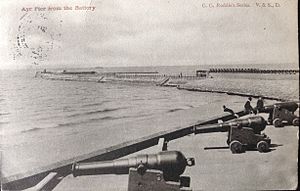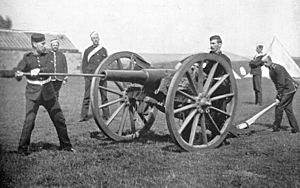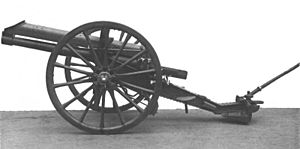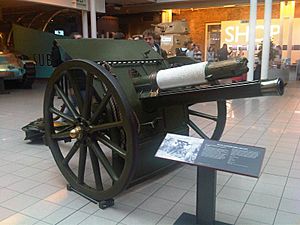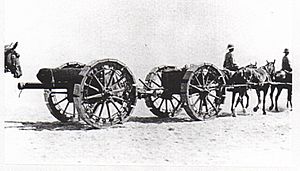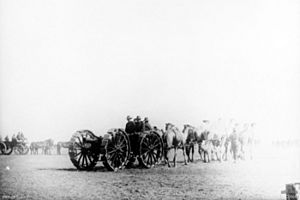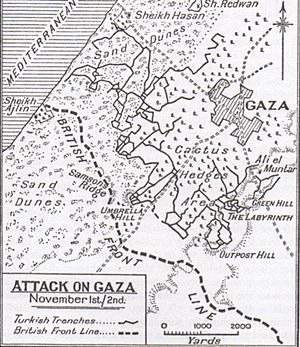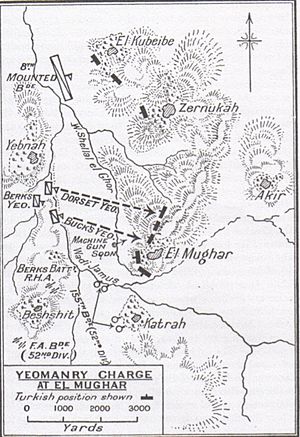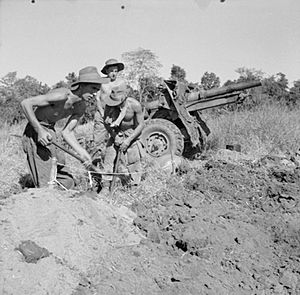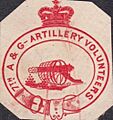1st Ayrshire and Galloway Artillery Volunteers facts for kids
Quick facts for kids 1st Ayrshire & Galloway Artillery Volunteers2nd Lowland Brigade, RFA 79th (Lowland) Field Regiment, RA 279 (City of Glasgow & Ayrshire) Field Regiment, RA |
|
|---|---|
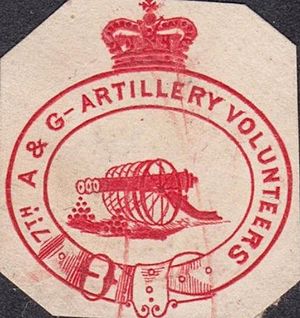
Letterhead with crest of one of the Ayrshire and Galloway Artillery Volunteer Corps, c1895
|
|
| Active | 1860–1967 |
| Country | |
| Branch | |
| Type | Artillery Regiment |
| Role | Garrison Artillery Position Artillery Field artillery |
| Part of | 52nd (Lowland) Infantry Division |
| Garrison/HQ | Irvine (1860–63, 1908–20) Ayr (from 1863) Kilmarnock (1889–1908) Troon (from 1961) |
| Engagements | Palestine North West Europe Burma |
The 1st Ayrshire and Galloway Artillery Volunteer Corps was a group of part-time soldiers. It started in 1859 because people worried about a French invasion. Later, it joined the Territorial Force (TF) in 1908. Its units fought with the 52nd (Lowland) Infantry Division in Palestine during World War I. They also fought in North West Europe and Burma during World War II. The unit continued as part of the Territorial Army (TA) until it merged with other units in 1967.
Contents
Artillery Volunteers: How the Unit Began
In 1859, many people were excited to join the Volunteer movement. This happened after fears of an invasion. Many new Rifle and Artillery Volunteer Corps were created. These were groups of part-time soldiers. They wanted to help the regular British Army if needed.
The 1st Administrative Brigade of Ayrshire Artillery Volunteers was formed in November 1860. Its main office (HQ) was in Irvine, North Ayrshire. It included several Artillery Volunteer Corps (AVCs) from Ayrshire:
- The 1st Corps started in Irvine in December 1859.
- The 2nd Corps started in Ayr in January 1860.
- The 3rd Corps started in Largs in March 1860.
- The 4th Corps started in Ardrossan in March 1860.
- The 5th Corps started in Kilmarnock in July 1860.
In 1863, more corps joined the brigade:
- The 1st Kirkcudbright Artillery Volunteers from Kirkcudbright.
- The 1st Wigtown Artillery Volunteers from Stranraer.
- The 2nd Wigtown Artillery Volunteers from Port Patrick.
- The 3rd Wigtown Artillery Volunteers from Sandhead (joined in 1867).
The first leader of the brigade was Major Sir Edward Hunt-Blair. In 1863, the brigade's HQ moved from Irvine to Ayr. In May 1880, the brigade became the 1st Ayrshire & Galloway Artillery Volunteers. It had 11 batteries (groups of guns) and its HQ was in Ayr.
Position Artillery: Moving the Guns
At first, these volunteer artillery groups were meant to guard fixed defenses. But some early units used 'position batteries'. These were smooth-bore field guns pulled by farm horses. The idea of using these mobile guns came back in 1888. Some volunteer batteries were then set up to work with infantry (foot soldier) brigades.
In 1889, the 1st Ayrshire & Galloway unit received a position battery of 16-pounder Rifled Muzzle Loading (RML) guns. These were operated by the two Kilmarnock batteries. That year, the unit's HQ moved to Kilmarnock.
In 1901, the unit received two more batteries of 9 Pounder Rifled Muzzle Loading (RML) guns.
Royal Garrison Artillery: A New Branch
In 1882, all the volunteer artillery units joined different parts of the Royal Artillery (RA). The 1st Ayrshire & Galloway AVC became part of the Scottish Division. In 1899, the RA split into two main parts: field artillery and garrison artillery. The volunteer artillery units were all assigned to the Royal Garrison Artillery (RGA).
On January 1, 1902, the unit changed its name to the 1st Ayrshire and Galloway Royal Garrison Artillery (Volunteers). Its HQ was in Kilmarnock. The next year, the position batteries were called heavy batteries. By 1903, modern 4.7-inch Quick Firing (QF) guns replaced the older RML guns.
The unit practiced shooting their guns at Irvine. They also trained with rifles at a range near Irvine. In 1900, over 600 men from the unit wanted to fight in the Second Boer War. However, they were not needed as artillery soldiers. Twenty-eight men did serve in South Africa with other units.
Territorial Force: Modernizing the Army
In 1908, the volunteer units became part of the new Territorial Force (TF). This was part of the Haldane Reforms to modernize the British Army. The 1st Ayrshire and Galloway RGA (V) was supposed to become the III (or 3rd) Lowland Brigade in the Royal Field Artillery (RFA).
However, the plans changed. The Wigtownshire Battery was soon disbanded. The Ayrshire battery grew to two batteries. By October 1908, the brigade was renumbered as II (2nd). This gave it its final structure:
II Lowland Brigade, RFA
- HQ at Irvine
- 1st Ayrshire Battery at Irvine
- 2nd Ayrshire Battery at Kilmarnock
- Kirkcudbright Battery at Kirkcudbright
- 2nd Lowland Ammunition Column at Ardrossan
The II Lowland Brigade was part of the TF's Lowland Division. Each battery received four 15-pounder guns.
World War I: Fighting Overseas
Mobilisation for War
The Lowland Division was at its yearly training camp when the order to prepare for war came in August 1914. Soldiers began gathering at their local drill halls. They performed guard duties until August 10, when the division moved to its war locations in Scotland. The II Lowland Brigade was stationed near Stirling. One battery was sent to Invergordon to protect a naval base.
When the war started, TF units were asked if they would volunteer to serve overseas. Many men did. To prepare, a second, or '2nd Line', unit was created for each original unit. These new units had the same names but with a '2/' in front. This created duplicate batteries, brigades, and divisions.
1/II Lowland Brigade: From Egypt to Palestine
In Egypt
In May 1915, the Lowland Division became the 52nd (Lowland) Division. It then began sailing to the Mediterranean. The plan was to help in the Gallipoli Campaign. The 1/II Lowland Brigade was one of the units that went with the division. They sailed to Port Said in Egypt, arriving in June.
The 1/II Lowland Brigade stayed in Egypt during the entire Gallipoli campaign. In March 1916, the 52nd (Lowland) Division returned to Egypt. It took over part of the Suez Canal defenses. Two sections of the brigade were sent to Egypt's western border to defend against the Senussi. Their old 15-pounder guns were pulled by camels through the desert.
The next month, the brigade received modern 18-pounder guns. These guns had 'ped-rails', which were wooden blocks on the wheels. These stopped the guns from sinking into the soft sand. On May 28, 1916, the brigade was renamed CCLX (or 260) Brigade, RFA.
In July, two of the brigade's batteries were moved forward to Romani. When the Turks attacked on August 4 (the Battle of Romani), the batteries fired their new 18-pounders. They had not used them before. The artillery helped stop the Turkish attack. The British artillery had very few casualties.
After this battle, the British stayed in their positions for several months. On September 15, the CCLX Brigade was renumbered as CCLXI (261) Brigade. In September, the Egyptian Expeditionary Force (EEF) began preparing to attack into Palestine. The 52nd (Lowland) Division helped cover the building of a railway and water pipeline into the Sinai Desert.
Battles in Gaza
In March 1917, the EEF attacked Gaza. The 52nd (Lowland) Division was in reserve and its artillery did not fight in the First Battle of Gaza. This battle failed to capture the city. The division then took part in the Second Battle of Gaza starting on April 17. The EEF's artillery bombarded the Turkish positions. The CCLXI Brigade supported the 52nd (Lowland) Division's attack. The howitzers fired gas shells and then high explosive shells. The 18-pounders created a moving wall of fire (a Creeping barrage) for the advancing infantry.
The attack was difficult. The gas shelling did not stop the Turkish artillery and machine guns. The Turkish artillery fired back, hitting one of CCLXI Brigade's observation posts. The attacks were held up, and the division had heavy casualties. A period of trench warfare followed. The 52nd (Lowland) Divisional Artillery suffered many losses because the enemy had better observation aircraft.
The EEF was reorganized, and artillery ammunition supply improved. The attack started again on November 1, 1917, with the Third Battle of Gaza. The bombardment was very heavy. The 156th Brigade attacked and quickly took Umbrella Hill. After more fighting, the front line trenches were captured. A large Turkish counter-attack was destroyed by all the artillery. The rest of the EEF broke through the Turkish lines further inland. By November 7, the Turks left Gaza. The 52nd (Lowland) Division chased them.
The pursuit continued. The Turks held a position at El Mughar. The CCLXI Brigade fired an intense bombardment to support the attack on Mughar Ridge. The important Junction Station fell to the British the next day.
On November 19, the EEF moved east into the Judaean Hills to close in on Jerusalem. Moving artillery on the hill roads was very hard. Heavy rain made conditions worse. But the 52nd (Lowland) Divisional Artillery managed to get 10 guns into position. Although the attack failed, Jerusalem fell without a fight on December 9.
On December 5, the 52nd (Lowland) Division moved to the coast north of Jaffa. They were overlooking the River Auja. The Turks were in a strong position. During the night of December 20/21, the 52nd (Lowland) Division's infantry crossed the Auja River. The artillery provided a creeping barrage. The Royal Engineers built bridges, and the artillery crossed on December 22. The division advanced quickly to Arsuf.
Final Battles and Peace
The division stayed near Arsuf until March 1918. Urgent reinforcements were needed on the Western Front, so the 52nd (Lowland) Division was sent there. However, its artillery units stayed in Palestine. They were exchanged with the 7th (Meerut) Divisional Artillery on April 3, 1918. The Lowland artillery then served with this Indian Army formation until the end of the war.
There was little fighting in the coastal area during the summer of 1918. The EEF was ready to launch its final attack in Palestine, the Battle of Megiddo, on September 19. There was no long bombardment before the attack. When the guns fired at 4:30 AM, it was the signal for the infantry to advance. The field guns bombarded the enemy lines. The 18-pounders then created a creeping barrage. The 7th (Meerut) Division broke through the front line. The artillery moved up to support them.
The cavalry then spread out across the Plain of Sharon. The 7th (Meerut) Division reached Haifa on September 29. They then marched towards Beirut. The artillery horses struggled in the hot sun. The infantry advanced faster than the artillery.
The Lowland gunners reached Tripoli on October 26. They had marched about 270 miles in 38 days. Fighting with Turkey ended with the Armistice of Mudros on October 30.
The Lowland Artillery stayed at Tripoli until November 22. Many soldiers died from disease there. The brigades then moved back to Egypt, reaching Cairo on December 20. In March 1919, there were civil disturbances in Egypt. The gunners formed mobile groups for patrol work. They stayed at Abbassia Barracks outside Cairo until August, when they were sent home. The CCLXI Brigade, RFA, was then put into 'suspended animation', meaning it stopped existing for a while.
2/II Lowland Brigade: Home Service
The 2/II Lowland Brigade served with the 2nd Lowland Division (later the 65th (2nd Lowland) Division) in Scotland and England. It was renamed CCCXXVI (or 326) Brigade, RFA, in May 1916. In early 1917, the division was sent to Ireland. It was broken up in early 1918, but the 326 Brigade stayed in Kildare until it was fully disbanded in October 1919.
Between the World Wars
The 2nd Lowland Brigade was reformed in 1920. It was renamed the 79th (Lowland) Brigade, RFA, in 1921. This was when the TF became the Territorial Army (TA). It remained part of the 52nd (Lowland) Division. It had its HQ in Ayr and batteries in Ayr, Irvine, Kirkcudbright, and Kilmarnock.
From 1938, Field Brigades were called Field Regiments. The TA field artillery units usually had four batteries. Three had 18-pounders, and one had 4.5-inch howitzers. These were all from World War I. However, in peacetime, batteries only had four guns. The guns were still pulled by horses. From 1927, some mechanization began. In 1924, the RFA became part of the Royal Artillery (RA).
World War II: Two Regiments Fight On
Preparing for War
After the Munich Crisis, the TA doubled in size. Most regiments split to form new, duplicate units. Field regiments changed from four six-gun batteries to two batteries, each with three four-gun troops. For the 79th (Lowland) Field Regiment, this meant it split into two units from June 12, 1939:
79th (Lowland) Field Regiment, Royal Artillery
- HQ at Ayr
- 313 (Ayr) Field Battery
- 314 (Irvine) Field Battery
130th Field Regiment, Royal Artillery
- HQ at Kilmarnock
- 315 (Kirkcudbright) Field Battery
- 316 (Kilmarnock) Field Battery
79th (Lowland) Field Regiment: Fighting in Europe
The 79th Field Regiment joined the 52nd (Lowland) Infantry Division. It served with this division throughout World War II. After the Battle of France, it was clear that having only two batteries was not enough. So, field regiments were reorganized into three 8-gun batteries. By March 1941, the 79th (Lowland) Field Regiment had three batteries: 313, 314, and 457 Field Batteries.
The regiment fought with the 52nd (Lowland) Division in the campaign in North West Europe. This was from October 1944 until VE Day (Victory in Europe Day). The regiment was put into suspended animation on May 10, 1946.
130th (Lowland) Field Regiment: Fighting in Burma
The 130th Field Regiment joined the 15th (Scottish) Infantry Division. It served with this division in the early years of the war. By March 1941, the regiment formed its third battery, 494 Field Battery. It was allowed to use the 'Lowland' subtitle in February 1942.
The regiment left the 15th (Scottish) Division in January 1942 and sailed to India. There, it joined the 14th Indian Infantry Division and later the 36th Indian Division. It fought with them in the Burma Campaign. The 36th Indian Division became the 36th British Division in September 1944 and continued fighting in Burma.
The 130th (Lowland) Field Regiment was put into suspended animation on September 30, 1946.
After World War II
When the TA was reformed on January 1, 1947, the 79th became the 279 (Lowland) Field Regiment in Ayr. The 130th became the 330 (Lowland) Medium Regiment in Troon (later Kilmarnock).
On July 1, 1950, the Lowland regiments were reorganized. The 279 (Lowland) Field Regiment absorbed most of the Greenock-based 328 (Lowland) Medium Regiment. The 330 (Lowland) Medium Regiment changed to a Light Anti-Aircraft (LAA) role.
When Anti-Aircraft Command was ended on March 10, 1955, the 279 Field Regiment and 330 LAA Regiment merged. They became the 279 (Ayrshire) Field Regiment.
In 1961, the TA was reduced in size. Most of the 279 (Ayrshire) Field Regiment merged with the 280 (Lowland – City of Glasgow) Medium Regiment. They formed the 279th (City of Glasgow & Ayrshire) Field Regiment. Its HQ was in Troon.
When the TA was further reduced in 1967, the regiment merged with other units. It became part of the Glasgow-based Lowland Regiment, RA. The Lowland Regiment was later reduced to a small group (a cadre) in 1969 and disbanded in 1975. However, in 1986, the 105 (Scottish) Air Defence Regiment was named as its successor unit.
Uniforms Through the Years
The first uniforms of the 1st and 2nd Ayrshire Artillery Volunteer Corps were blue jackets. They had red collars, cuffs, and piping. Black braid was used for decoration. They also wore blue trousers with a black stripe and red piping. Their blue peaked caps had a black band and a silver grenade badge. Black waist-belts completed the uniform. The 1st Wigtown unit had blue uniforms with scarlet (bright red) parts, white belts, and silver badges.
Images for kids


